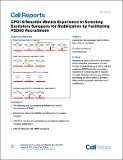| dc.contributor.author | Subramanian, Jaichander | |
| dc.contributor.author | Michel, Katrin | |
| dc.contributor.author | Benoit, Marc | |
| dc.contributor.author | Nedivi, Elly | |
| dc.date.accessioned | 2022-06-30T16:46:10Z | |
| dc.date.available | 2021-10-27T20:35:11Z | |
| dc.date.available | 2022-06-30T16:46:10Z | |
| dc.date.issued | 2019 | |
| dc.identifier.uri | https://hdl.handle.net/1721.1/136399.2 | |
| dc.description.abstract | © 2019 The Authors A key feature of brain plasticity is the experience-dependent selection of optimal connections, implemented by a set of activity-regulated genes that dynamically adjust synapse strength and number. The activity-regulated gene cpg15/neuritin has been previously implicated in stabilization and maturation of excitatory synapses. Here, we combine two-photon microscopy with genetic and sensory manipulations to dissect excitatory synapse formation in vivo and examine the role of activity and CPG15 in dendritic spine formation, PSD95 recruitment, and synapse stabilization. We find that neither visual experience nor CPG15 is required for spine formation. However, PSD95 recruitment to nascent spines and their subsequent stabilization requires both. Further, cell-autonomous CPG15 expression is sufficient to replace experience in facilitating PSD95 recruitment and spine stabilization. CPG15 directly interacts with α-amino-3-hydroxy-5-methyl-4-isoxazolepropionic acid (AMPA) receptors on immature dendritic spines, suggesting a signaling mode for this small extracellular molecule acting as an experience-dependent “selector” for spine stabilization and synapse maturation. Experience plays a key role in formation and continuous optimization of brain circuits. Subramanian et al. show that the molecule CPG15/neuritin can replace experience in selecting which nascent contacts between neurons are retained, facilitating the recruitment of proteins that promote synapse maturation and stabilization. | en_US |
| dc.language.iso | en | |
| dc.publisher | Elsevier BV | en_US |
| dc.relation.isversionof | 10.1016/j.celrep.2019.07.012 | en_US |
| dc.rights | Creative Commons Attribution-NonCommercial-NoDerivs License | en_US |
| dc.rights.uri | http://creativecommons.org/licenses/by-nc-nd/4.0/ | en_US |
| dc.source | Elsevier | en_US |
| dc.title | CPG15/Neuritin Mimics Experience in Selecting Excitatory Synapses for Stabilization by Facilitating PSD95 Recruitment | en_US |
| dc.type | Article | en_US |
| dc.contributor.department | Picower Institute for Learning and Memory | en_US |
| dc.contributor.department | Massachusetts Institute of Technology. Department of Biology | en_US |
| dc.contributor.department | Massachusetts Institute of Technology. Department of Brain and Cognitive Sciences | en_US |
| dc.relation.journal | Cell Reports | en_US |
| dc.eprint.version | Final published version | en_US |
| dc.type.uri | http://purl.org/eprint/type/JournalArticle | en_US |
| eprint.status | http://purl.org/eprint/status/PeerReviewed | en_US |
| dc.date.updated | 2019-10-03T16:09:56Z | |
| dspace.orderedauthors | Subramanian, J; Michel, K; Benoit, M; Nedivi, E | en_US |
| dspace.date.submission | 2019-10-03T16:09:59Z | |
| mit.journal.volume | 28 | en_US |
| mit.journal.issue | 6 | en_US |
| mit.license | PUBLISHER_CC | |
| mit.metadata.status | Publication Information Needed | en_US |
